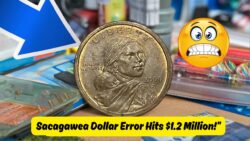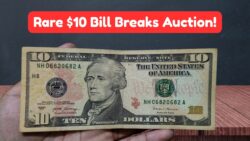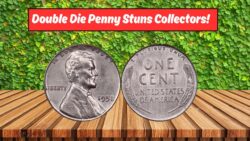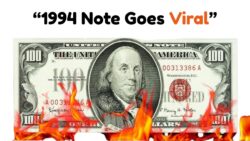Repeater Serial Numbers – If you’ve ever looked closely at a $1 bill, you might have noticed the small serial number printed twice on the front. While most people don’t pay much attention to it, currency collectors—known as numismatists—sure do. And if that number happens to be a “repeater,” you could be holding something worth thousands of dollars. Yes, some $1 bills with unique serial numbers have been sold for as much as $9,999, making them a treasure hiding in plain sight. This article breaks down everything you need to know about $1 bills with repeater serial numbers, including what they are, why collectors value them so highly, how much they’re worth, and how you can check your wallet or cash drawer for these little-known gems.
What Is a ‘Repeater’ Serial Number?
Repeater serial numbers are exactly what they sound like: numbers that repeat in a recognizable pattern. On U.S. currency, serial numbers consist of 8 digits, sometimes with letters at the start and end. A “repeater” is a bill where the pattern of numbers repeats itself—usually in equal halves.
Common Examples of Repeater Serial Numbers:
- 12341234 – The first four digits repeat.
- 34343434 – The pattern “34” repeats.
- 20202020 – The numbers repeat every two digits.
- 88888888 – Also known as a “solid,” which is extremely valuable.
Collectors value these notes because they are rare, interesting, and visually unique.
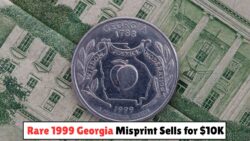 This 1999 Georgia Quarter With Misprint Just Hit $10,000 at Auction – Still in Circulation!
This 1999 Georgia Quarter With Misprint Just Hit $10,000 at Auction – Still in Circulation!
Why Are Repeater Serial Numbers So Valuable?
To understand the value of repeater notes, it’s important to know that not all dollar bills are created equal. The U.S. Bureau of Engraving and Printing prints billions of bills each year, but the odds of getting a perfectly repeating pattern are slim.
Reasons Behind the Value:
- Rarity: A genuine repeater is very rare, especially on circulated $1 bills.
- Visual Appeal: The symmetry is aesthetically pleasing and often catches the eye of collectors.
- Demand: Currency collectors are always on the hunt for unique and unusual patterns.
- Uncirculated Condition: Bills in mint or near-mint condition get top dollar.
Some repeater notes have been auctioned or sold online for over $1,000, and rare combinations have fetched as much as $9,999.
Types of Repeater Serial Numbers to Watch For
Not all repeating serial numbers are equal. Some types are more desirable than others depending on the complexity and clarity of the pattern.
Most Valued Types:
| Type | Example | Approx. Value Range |
|---|---|---|
| True Repeater (4+4) | 12341234 | $500 – $3,000+ |
| Two-Digit Repeater | 34343434 | $250 – $2,000 |
| Solid Numbers | 88888888 | $1,000 – $9,999 |
| Super Repeater (e.g., ABABABAB) | 12121212 | $300 – $2,500 |
| Radar-Repeater Hybrid | 12344321 | $750 – $3,000 |
| Repeater Star Notes | 12121212* | $1,000 – $4,000+ |
How to Check If You Have a Repeater Note
It’s easy to miss a valuable repeater if you don’t pay attention. Here’s a quick guide to checking your cash.
Steps to Identify a Repeater Note:
- Look at the Serial Number: It’s printed twice on the front side of every bill.
- Check for Patterns: Does the number repeat exactly? For example, 56565656 or 50505050.
- Condition: Is the bill clean, crisp, and uncirculated? Condition matters.
- Match With Online Databases: Some sites list known serial number patterns and past auction prices.
- Avoid Fakes: Make sure the bill is genuine and issued by the U.S. Treasury.
Where to Sell or Appraise Your Repeater $1 Bill
Once you’ve spotted a repeater note, you may be wondering how to find out its value or where to sell it.
Best Places to Appraise or Sell:
- eBay and Auction Sites: Many collectors buy directly from eBay sellers.
- Local Coin & Currency Shops: Experts can help evaluate the condition and worth.
- Currency Forums: Reddit communities like r/papermoney and r/numismatics are great for getting opinions.
- Professional Appraisal Services: Companies like PMG (Paper Money Guaranty) grade and certify banknotes.
Tips to Increase Value Before Selling
Here are a few things you can do to ensure you get the highest possible price for your repeater $1 bill.
Value-Boosting Tips:
- Keep the Bill Flat: Avoid folding it—creases reduce value.
- Store Properly: Use protective sleeves to prevent wear and tear.
- Get It Graded: Professionally graded bills sell for higher prices.
- List With Good Photos: If selling online, upload clear, close-up images of the serial number and condition.
- Highlight the Pattern: In your listing or appraisal, mention the type of repeater clearly.
A regular $1 bill might seem insignificant, but the serial number can make it worth a small fortune. Whether you’re a collector, a casual enthusiast, or someone just curious, start checking your change. Repeater serial numbers are not just cool—they can be seriously profitable. And the best part? They could be hiding in your wallet right now. Start paying attention to those tiny numbers—you might be just one discovery away from a $9,999 jackpot!
FAQs
Q1. What is a repeater serial number on a $1 bill?
A repeater serial number is a number that repeats in a consistent pattern, such as 12341234 or 56565656.
Q2. How much can a repeater $1 bill be worth?
Depending on rarity and condition, it can range from $250 to $9,999.
Q3. Where can I sell a repeater note?
You can sell it on eBay, through currency dealers, or at auction sites and coin shows.
Q4. Does the condition of the bill matter?
Yes, uncirculated or mint-condition bills fetch the highest prices from collectors.
Q5. Are star notes with repeater serials worth more?
Absolutely. A star note with a repeater pattern is extremely rare and valuable.


